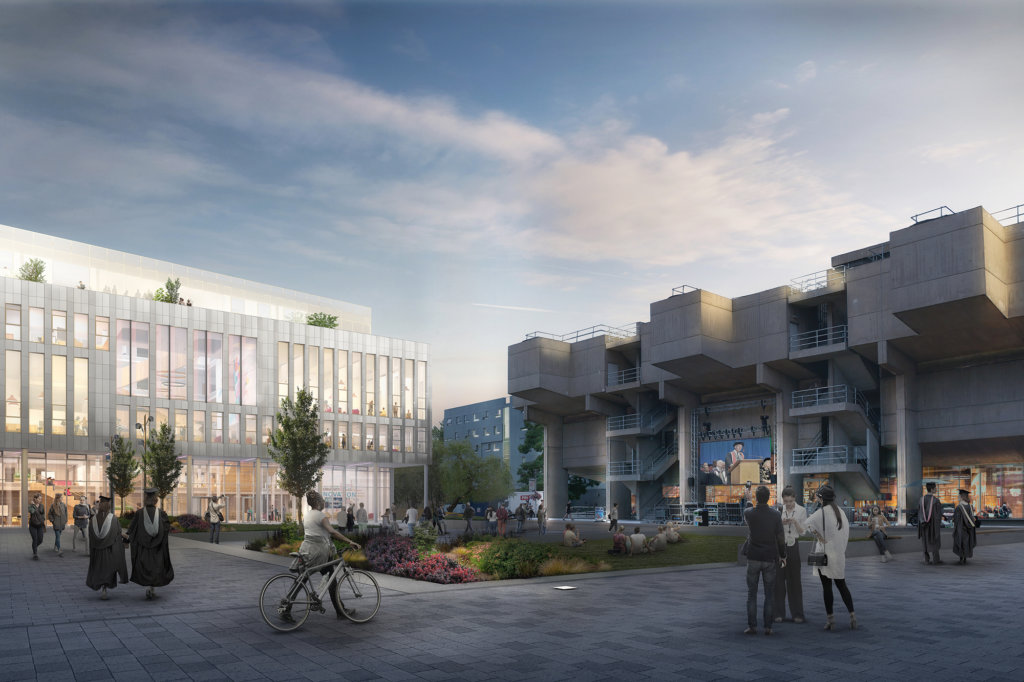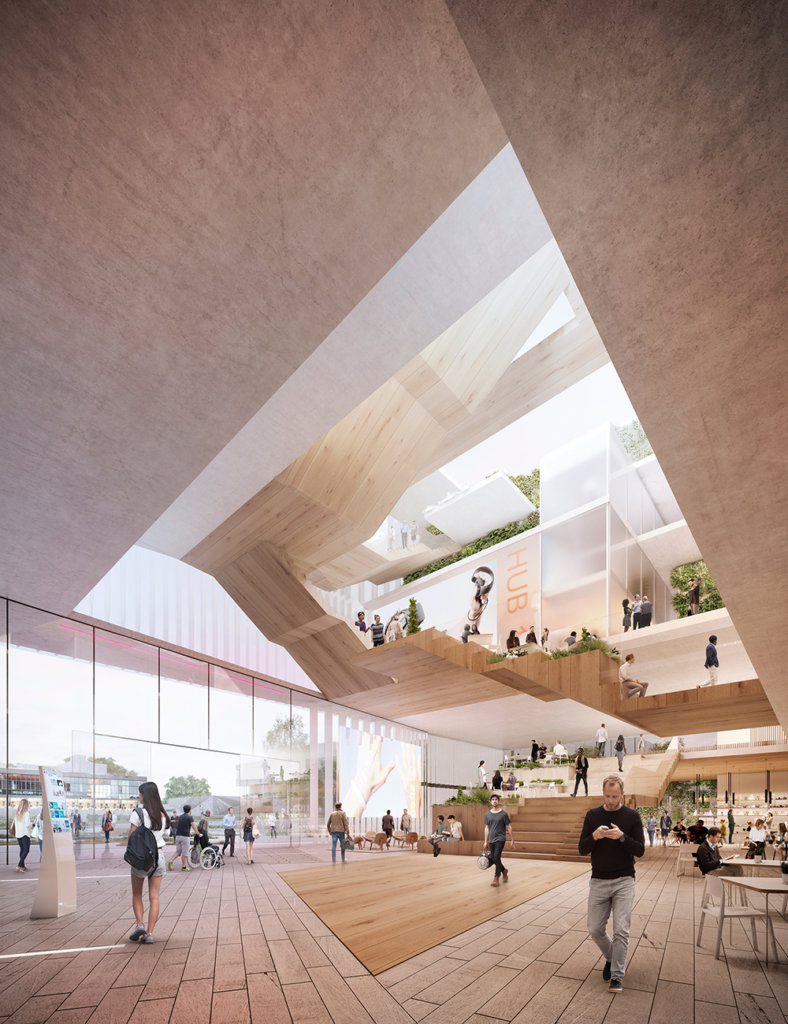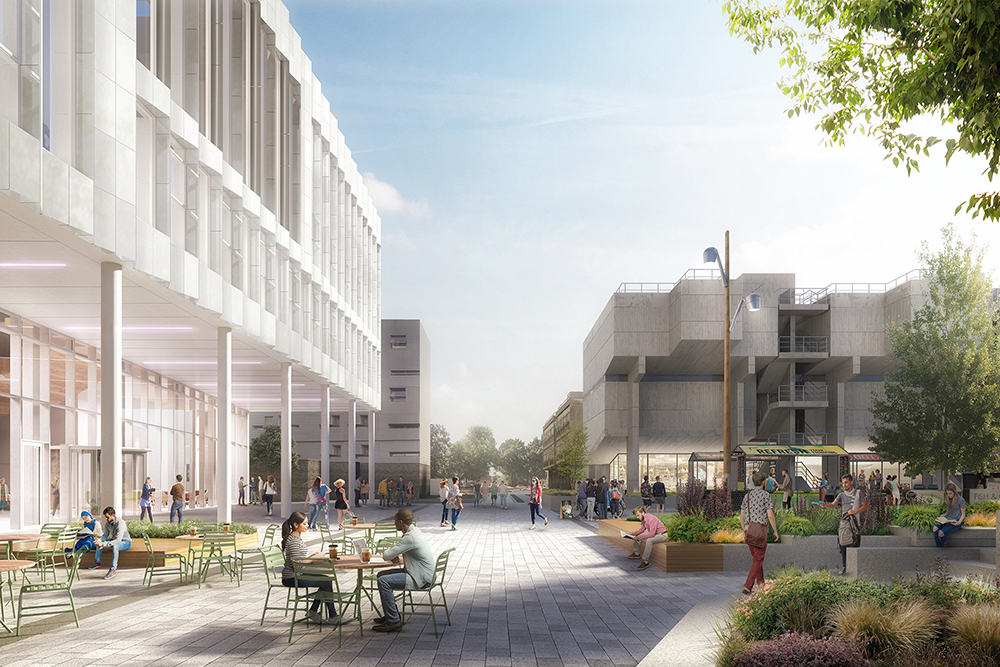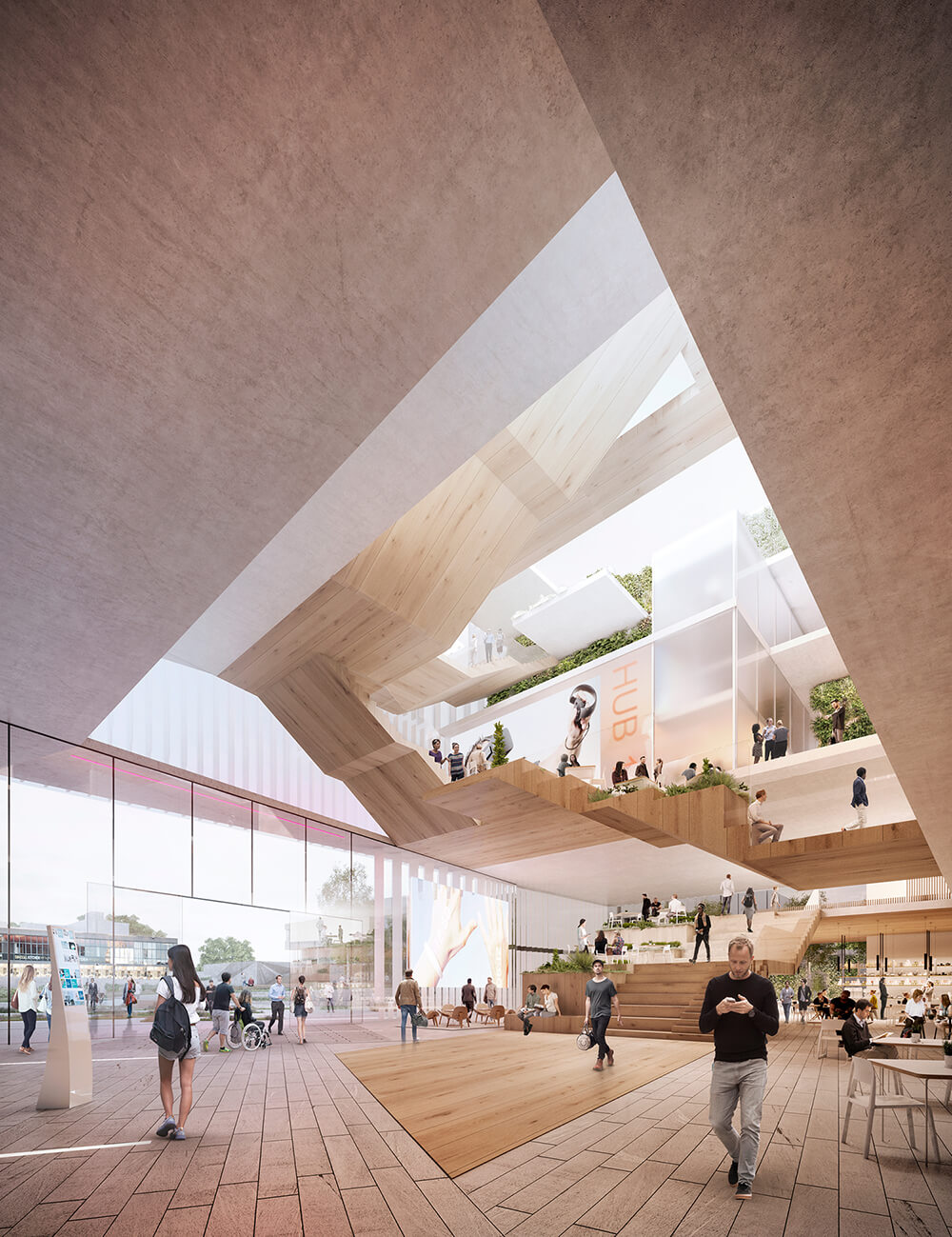
Designed by Richard Sheppard and John Stillman, the original Brunel University Lecture Centre was completed in 1968. Now a Grade II listed building, it famously featured in the 1971 Stanley Kubrick film A Clockwork Orange. The imposing concrete building dominates the site, housing six large lecture theatres and a collection of smaller lecture theatres and classrooms in a single block.
While traditional lectures still have an important role to play in university education, Brunel recognised that it needed a building that would enable it to embrace new ways of teaching. However, with its traditional learning spaces centred around lecture theatres, there was little flexibility in its existing design and layout to allow for a change of teaching style. With this in mind, the university opted to build afresh.
Brunel wanted the new Learning and Teaching Centre to be a counterpoint to the Brutalist Lecture Centre. The brief was that the building should support peer-to-peer learning first and foremost, with flexibility built in for changes in teaching methods over the next 30-50 years.
Modelling a competition-winning concept
Penoyre & Prasad entered the design competition for the project, following an initial consultation process that was just three weeks long.
“We used Archicad from day one and it played a big part in helping us win the design competition.
“The ability to rapidly model enabled us to work through lots of ideas very quickly to come up with our winning concept. At the competition stage we made good use of Graphisoft’s BIMx virtual reality viewer, too. We took an iPad into the interview and the client was amazed to see how easily we could flip from the floor plan to a 3D model and back again, focusing in on different areas.
“As we moved further through the project the scheduling and detailing tools within the software really came into their own.”
Michael Fostiropolous, Penoyre & Prasad

Meeting stakeholder needs
After winning the competition, Penoyre & Prasad undertook an intense consultation period which meant balancing many different stakeholder requirements at the university – for example, the differing needs of students and teachers.
One challenge was the new building’s relatively small footprint, which meant it needed to be built quite high, at seven storeys. As a result, and with large volumes of people coming in and out of lectures and seminars every hour, it was important to keep the circulation flowing.
To address this challenge, the building is designed around a central atrium and ‘living stair’ – a central timber staircase that it’s hoped will encourage students and staff to linger and socialise. With this layout, there are no corridors; instead, a deliberately fluid space that enables students and staff to congregate in the social learning spaces that are located around the central atrium. Formal teaching areas are reconfigurable thanks to sliding, folding walls which allow for smaller spaces to be interconnected, flexibly accommodating groups from 40-250 in a single space.
The staircase and attached seating are both made of timber, designed to give a more inviting and homely feel to the space, with planting and soft furnishings providing a finishing touch.
To ensure the living stair could be accessed and enjoyed by everyone, Penoyre & Prasad worked closely with the university’s accessibility team throughout the project, regularly using BIMx to explain ideas and designs.
Michael explains: “We met with the engagement committee, which represents different groups at the university, once a month. We always had a BIMx model on the projector and used it to look at the implications of that particular discussion. There was always something in the model that we could use to help people visualise what we were talking about.”
Challenging planning process
The planning department was keen that the new building should not overpower the existing listed lecture block. With this in mind, Penoyre & Prasad designed the Learning and Teaching Centre to be both lightweight and transparent, in direct juxtaposition to the brutalist architecture of the lecture block.
Michael says: “Once again, both BIMx and the fly-through movies produced from ARCHICAD were invaluable in helping us demonstrate to the planners that the new building would enhance, rather than overshadow the adjacent listed building.”
In addition, Penoyre & Prasad and landscape architects Oobe re-designed the central Quad between the listed building and the new Learning and Teaching Centre, to help knit the fabric of the campus together. By bringing together grading and green space, lighting and furniture as part of a cohesive material palette, the new Quad has become a much more accessible and inviting space at the heart of the campus, and a continuation of the living stair.
Artisan meets high-tech
Penoyre & Prasad also employed ARCHICAD in a craft-focused way to design bespoke ceramic panels for the building façade. The 3D geometry of the panels was incredibly complex, but with the help of ARCHICAD’s slab and column elements, the architects could quickly test configurations and model all 5,455 individual panels without making the model too large.
Michael explains: “We worked with a ceramicist, Lydia Johnson of Fettle Studio, who is also an ARCHICAD user, to perfect a selection of natural glazes that will create a pearlescent effect for the façade. Once we’d agreed on the design, we brought in an industrial manufacturer from Germany to produce the panels.”
Information was shared via IFC with the manufacturer. Penoyre & Prasad also produced 3D printed façade mock-ups as a tangible example for the client consultations.
Michael adds: “The ARCHICAD model helped to demonstrate not only the design but also the buildability of the scheme with the specialist consultants.”

BIM Stage 2 Maturity
Brunel University is very focused on BIM protocols, and the employer’s requirements set a target of BIM Level 2 for the Learning and Teaching Centre. .
Michael continues: “This meant a challenging and rigorous process which included creating COBie outputs for each discipline and mapping ARCHICAD objects to COBie data structure. We used Uniclass classification throughout and every pipe and structural connection has been fully modelled by our engineering colleagues at BDP.”
Once building starts, it is expected to be completed within two years, with Penoyre & Prasad involved in the construction phase to assist the client.
Michael concludes: “We will continue to use ARCHICAD and BIMx throughout the construction phase and we expect both the ARCHICAD model and BIMx to help win hearts and minds with the team and subcontractors. It makes a huge difference at site inductions for suppliers and contractors to be able to see in advance what they are creating.”
About Penoyre & Prasad
Penoyre & Prasad is a RIBA chartered practice with 30 years’ experience across all sectors, providing full architectural, interior design, master planning and consultation services.
The practice has delivered over 300 schemes and achieved over 130 design awards. Its distinctive, collaborative design approach results in functional, beautiful and energy efficient buildings, which have received wide recognition through numerous design awards, publications and competition wins.
Whatever the project, Penoyre & Prasad’s aim is to design versatile and adaptable buildings, bringing to bear high ambition and fresh ideas, focused on the people who use, operate and experience the buildings and neighbourhoods.
About Graphisoft
Graphisoft® ignited the BIM revolution in 1984 with Archicad®, the industry first BIM software for architects. Graphisoft continues to lead the industry with innovative solutions such as its revolutionary BIMcloud®, the world’s first real-time BIM collaboration environment; and BIMx®, the world’s leading mobile app for lightweight access to BIM for non-professionals. Graphisoft is part of the Nemetschek Group.
